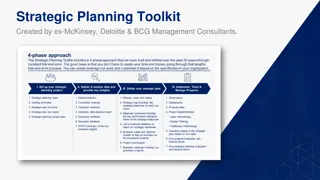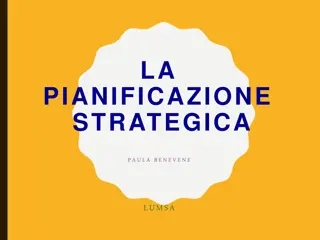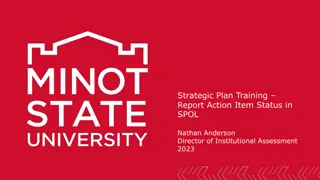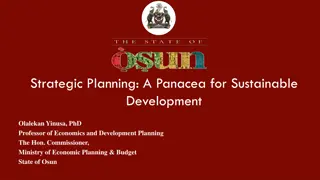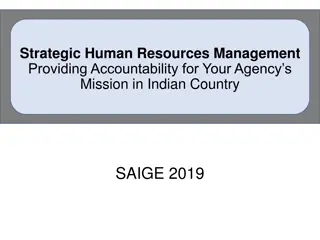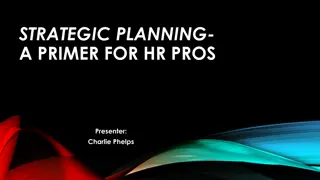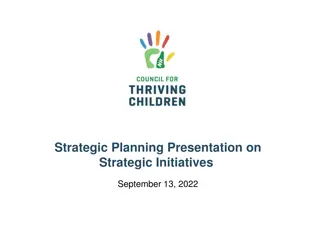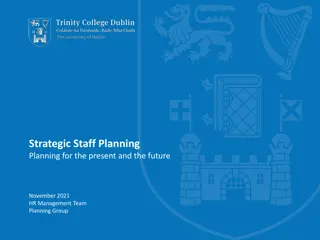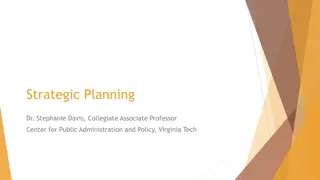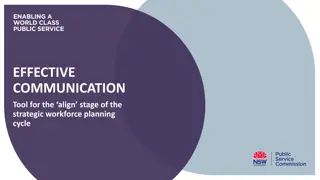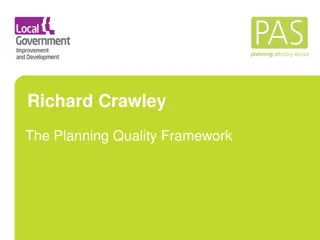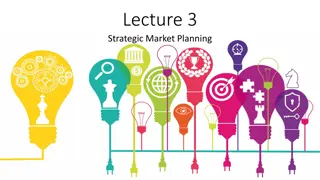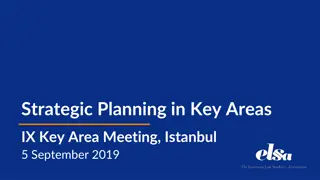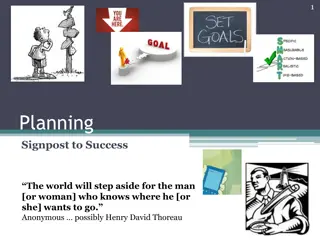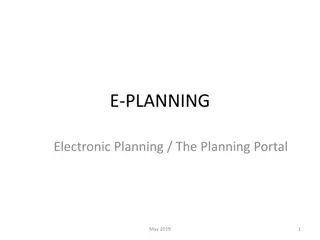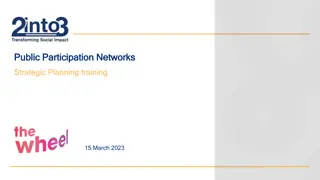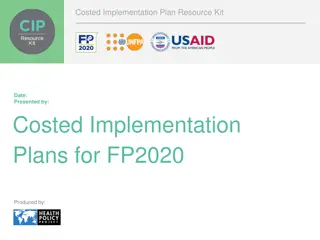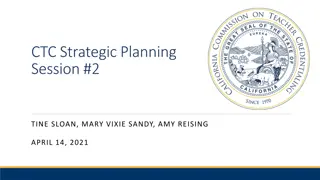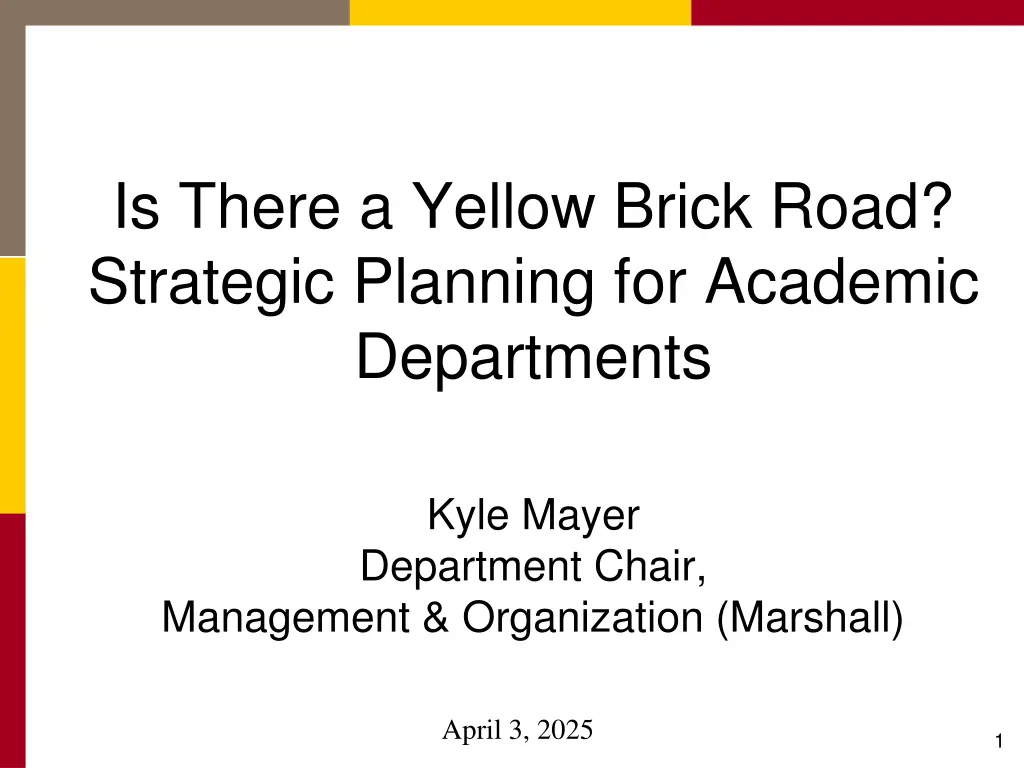
Strategic Planning for Academic Departments: Keys to Success
Discover the essential elements of strategic planning for academic departments, including the importance of creating a clear strategy, communication, organization, flexibility, and psychological safety. Learn how to engage department members effectively and prioritize goals for improved performance.
Download Presentation

Please find below an Image/Link to download the presentation.
The content on the website is provided AS IS for your information and personal use only. It may not be sold, licensed, or shared on other websites without obtaining consent from the author. If you encounter any issues during the download, it is possible that the publisher has removed the file from their server.
You are allowed to download the files provided on this website for personal or commercial use, subject to the condition that they are used lawfully. All files are the property of their respective owners.
The content on the website is provided AS IS for your information and personal use only. It may not be sold, licensed, or shared on other websites without obtaining consent from the author.
E N D
Presentation Transcript
Is There a Yellow Brick Road? Strategic Planning for Academic Departments Kyle Mayer Department Chair, Management & Organization (Marshall) April 3, 2025 1
Why Create a Strategic Plan? How do all members of the department know what to do? What guides the department actions on hiring? Curriculum? Culture? How will you improve department performance? What are the aspects of performance that are most important? Dept Chairs can t make all decisions, so a clear strategy guides the actions of everyone in the department 2
Overarching Keys to the Process Transparency & communication Keep everyone involved in why you are doing this, what to do, progress, etc. Organization Keep on top of things, check in with committee leads on progress, etc. Flexibility Listen to feedback and adjust if necessary Share findings with everyone involved Document the results with action plans 3
One Other Important Factor Agree up front on what is core to the department that you want to build on You need to have a general consensus on your strengths as a department and where you need some improvements What advantages or strengths do you want to build on? What are the weaknesses? What are the goals of the department You will always have multiple goals across teaching, research, service, but how do you prioritize while make room for each? How will you handle tradeoffs? 4
Need Psychological Safety But it must also be safe to disagree and debate!! 5
Engagement and Psychology Safety Matter You need to get people bought in to doing a strategic plan for the department Explain the need for it and how it will help address key issues and lead to a clearer plan for the future Also need to make sure that everyone s voice will be heard People need to be free to speak up or the process will not be effective For example, you can t have senior people intimidating junior people into being quiet 6
Subcommittee Creation Needs to Account for Psych Safety If you have issues with psych safety in your department, then create teams to try and minimize these issues Committee leaders need to be on board with making sure all voices are heard There can be a tendency for senior faculty to dominate the process, so take steps to set expectations for junior and clinical faculty to speak up (and for senior tenured faculty to listen to them) 7
Dept Chair Role in the Process Leader-initiator Set it up and get it started well Project manager Track progress and keep teams on task Do NOT try to take over and unduly influence any of the groups This is hard! Avoid getting too involved or being seen as trying to drive a predetermined outcome Guidance is good; control is not (fine line sometimes) Clearly communicate and document results 8
Step 1: Who to Involve First answer: Everyone in the department But not everyone through the entire process Levels of involvement: Lead the process: Dept Chair Advise on the process: Advisory Committee Should be small (2-4 people) to provide feedback and perspective to you as the dept chair. Sub-committee chairs Sub-committee members 9
Who to Involve (contd) All department faculty need to be involved in a committee (barring something unusual or sabbaticals) TT/T and RTPC Gray areas: PhD students & Staff Can involve in certain sub-committees but depends on where their perspective could be useful Particularly with staff, don t ignore them Often have valuable feedback on culture at least Adjunct faculty Consider including long standing adjuncts, but probably not newer ones unfamiliar with the department 10
Where to Start? What are the key strategic issues that need to be addressed in the strategic plan? This question will guide what committees you create and what questions you have them address 11
My Experience with MORs Strategic Planning Process The advisors helped me assess the right committees to create Our strategic issues: Hiring priorities (e.g., criteria for evaluation) Supporting research (especially junior faculty) Improving enrollment in electives Improving teaching quality Assess and improve the culture of the department 12
Getting Buy In You need to get everyone on board that this is a good idea Explain the types of issues that a strategic plan could address Point to tangible decisions and direction for the department that will emerge from creating a strategic plan It can be a chance to discuss some challenging topics that can be hard to bring up in regular department meetings 13
Need Clear Objectives for Each Committee Each committee needs to know exactly what questions to address These clear questions will guide who belongs on each committee Clear direction also focuses the effort, as some committees have a tendency for scope creep (or may avoid touchy issues) 14
Committee Objectives Drive Membership Who to put on each committee? Need to think about: Expertise Interest (what people care about Personalities!! This one is key! Can t ignore challenging faculty but have to put them in a situation where they at least can t derail things Also have to consider who gets along with whom (or where the conflicts are) and put faculty who don t get along on different committees. (Example from MOR)15
Committee Membership (contd) Committee leads Respect from colleagues is more important than rank Need leaders, not just senior faculty Must actually run the committee, so need to be good with people and organized Committee members People who care about the topic Mix of different areas (e.g., TT, T, and RTPC) But focus on those who are relevant e.g., we didn t include RTPC on TT/T hiring criteria committee People who work well together This last one is key!! You need cohesive groups. 16
Clear Objectives for Each Group Make deliverables very clear What problems to solve or issues to address Are they tasked with making decisions, providing recommendations, or merely highlighting key issues? I think having them recommend changes and then having the whole department discuss and make decisions is probably the best way to go Provide a clear timeline Have interim deliverables to check on status (The Department Chair has to be the project manager of the whole process) 17
Timeline Kickoff Include the entire department (everyone involved in the process) We even had PhD students there Goal is to get some excitement but also provide clear direction and roles Phase 1 Committees meet to start to address the key issues within their particular area Goal is to come up with preliminary recommendations Do any surveys, benchmarking, or other research if needed Concludes with presentation of initial recommendations18
Timeline (Contd) Phase 2 Committees address any feedback from the department Finalize recommendations and put together action plans Concludes with presenting draft of final recommendations to the department Phase 3 Bring everything together and finalize what will change and document everything into a strategic plan for the department 19
Kicking off the MOR Strategic Planning Process An Example 20
MOR Strategic Planning Kick-off USC is a great university, and Marshall is doing very well Lots of new faculty; donations are up with Geoff in charge MOR is doing well Enrollments in UG and grad classes are strong (not perfect, but strong) Strong publishing In leadership positions in the Dean s office Great faculty and staff and PhD students! (many of whom are pretty new) But how do we stay strong and continue to improve? That is the focus of our plans for this year
Start Today Get into four groups and discuss three questions What are MOR s main strengths that we can build on to improve ourselves? What are MOR s main weaknesses that could hold us back? What do we want MOR to look like in 5-7 years? I will collect the notes from each group and share with the department We can discuss them briefly today if we have time Here is the broader plan for our strategic review
Organization of Review: Research, Teaching and Culture Research: How do we improve the research environment in MOR? Two sub-committees Research environment & identity (co-chaired by Nan and Scott) How can we better support junior faculty in research? How can we better support Associate Professors in getting promoted to Full? How can we better assess recruiting priorities and identify key research areas? Can/should we do anything to encourage more practitioner- oriented research by tenured faculty? PhD Committee (co-chaired by Florenta and Eric) How can we improve the MOR PhD program? Recruiting? Required classes? Mentoring? And ultimately placement?
Organization of Review: Research, Teaching and Culture II Teaching: How do we improve teaching and enrollments in MOR? Two sub-committees Enhancing Teaching Quality (chaired by Marco) How can we better support our faculty as teachers? How to provide additional rewards/recognition and coaching where needed? How to identify faculty who may need coaching (before the Dean s office gets involved)? How can we encourage faculty to seek feedback and support and encourage innovation? Examining MOR Electives (co-chaired by Arvind and Nate) How can we improve MOR electives? Examine portfolio of electives and suggest changes. How can MOR best prepare for the changes coming to include more condensed and online electives for the revised PM and OMBA programs?
Organization of Review: Research, Teaching and Culture III Culture: How do we improve the culture in MOR? (While our culture may be strong, it could be better and even good things need review and adjustment over time.) Two culture sub-committees (one chaired by Becky, the other by Christian) Conduct a joint culture survey of MOR The two sub-committees will then evaluate the results separately and come up with their own recommendations and action plans for MOR Our culture is critical. How do we handle conflict? Are all voices heard? We need to make sure we have a super strong culture that supports all faculty and ensures an inclusive and supportive environment for all faculty, staff and students.
Timing and Process Sept 6 Kick off the process!! I will send a copy of the old strategic plan to everyone, which includes our vision and values Sept 7 October 31 Each sub-committee will meet (as many times as needed should be several times) to come up with a preliminary report (rough draft) to share at the fall retreat. November 1 Fall Retreat Each sub-committee will lead a discussion of the entire department on their ideas and get feedback as we discuss them. November 2 March 6 Each sub-committee will determine how best to incorporate the feedback from the department and draft a preliminary final proposal with recommendations March 7 Spring Retreat We will discuss the entirety of the plan going forward and any possible changes, plus we will discuss how to implement it. If there are lingering issues, we can address them in follow up meetings as needed May 2 MOR End of Year Meeting. Present the finalized plan to the department
Groups for Strategic Review Teaching Marco Peter C.* Nik Christine Peter K* Cheryl* Dan* Chris Marina Arvind* Nate* Christine Jody Research Nan* Scott* Nandini* Florenta* Eric* Shon* Joe* John* Melody* Andrea* Zack* Daphne* Culture Leigh Peer* Becky Sarah* Paul* Courtney Agi Tom* Christian Gordon * Denotes TT Faculty Both clinical and T/TT faculty are involved in the culture committee All faculty on the research committees are T/TT Both clinical and T/TT faculty are involved in the teaching committees, but mostly clinical
Sub-Committees for Strategic Review Culture Team Becky* Christian* Sarah Paul Gordon Courtney Tom Peer Leigh Agi Teaching Quality Marco* Peter C. Nik Christine Dan Cheryl Chris Electives Arvind* Nate* Peter K Carl Marina Jody Research Support Nan* Scott* Nandini Shon Andrea Joe PhD Program Florenta* Eric* John Melody Zack Daphne
Conclusion Strategic planning isn t an easy process, but it can be worth it The process requires organization and leadership People will get distracted and neglect this process if you don t keep them on task with regular check-ins and deliverables Make sure gain consensus at the beginning, communicate well, and wrap it up with clear deliverables and descriptions of what will change Plus document the strategic plan for the department so that you can refer back to it 29

